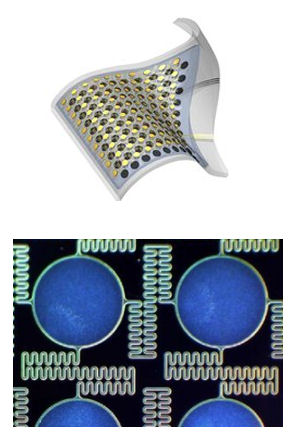26 February 2013
Stretchy battery can bend and twist
by Will Parker
 A team of scientists from Northwestern University and the University of Illinois are the first to demonstrate a stretchable lithium-ion battery - a flexible, wirelessly charged device that could power a range of innovative, stretchable electronic appliances. Northwestern's Yonggang Huang and the University of Illinois' John A. Rogers detail their invention in the journal Nature Communication.
A team of scientists from Northwestern University and the University of Illinois are the first to demonstrate a stretchable lithium-ion battery - a flexible, wirelessly charged device that could power a range of innovative, stretchable electronic appliances. Northwestern's Yonggang Huang and the University of Illinois' John A. Rogers detail their invention in the journal Nature Communication.
"We start with a lot of battery components side by side in a very small space, and we connect them with tightly packed, long wavy lines," explained Huang. "These wires provide the flexibility. When we stretch the battery, the wavy interconnecting lines unfurl, much like yarn unspooling. And we can stretch the device a great deal and still have a working battery." Rogers added that the battery can work for eight to nine hours before it needs recharging, which he says can be done wirelessly.
According to the researchers, the power and voltage of the stretchable battery are similar to a conventional lithium-ion battery of the same size, but the flexible battery can stretch up to 300 percent of its original size and still function.
Researchers and designers around the world have been working on a whole range of stretchable electronic devices, but until now a stretchable power supply has been a major stumbling block.
Huang's design solution is to use metal wire interconnects that are long, wavy lines, filling the small space between battery components. The unique mechanism is a "spring within a spring": the line connecting the components is a large "S" shape and within that "S" are many smaller "S's." When the battery is stretched, the large "S" first stretches out and disappears, leaving a line of small squiggles. The stretching continues, with the small squiggles disappearing as the interconnect between electrodes becomes taut. "We call this ordered unraveling," Huang said. "And this is how we can produce a battery that stretches up to 300 percent of its original size."
Cleverly, the battery's design allows for the integration of stretchable, inductive coils to enable charging through an external source but without the need for a physical connection (wireless charging).
Huang and Rogers say that wireless charging could open up many new applications, such as stretchable electronic devices that could be implanted inside the human body. These implantable electronics could monitor anything from brain waves to heart activity, succeeding, says Huang, where flat, rigid batteries would fail.
Related:
Discuss this article in our forum
Stanford announces peel-and-stick solar panels
"Paperphone" prototype demonstrates bend gesture interface
Flexible Electronics Melded With Contact Lens Creates Bionic Eye
New imaging device is flexible, flat, transparent, and disposable
Source: Northwestern University
